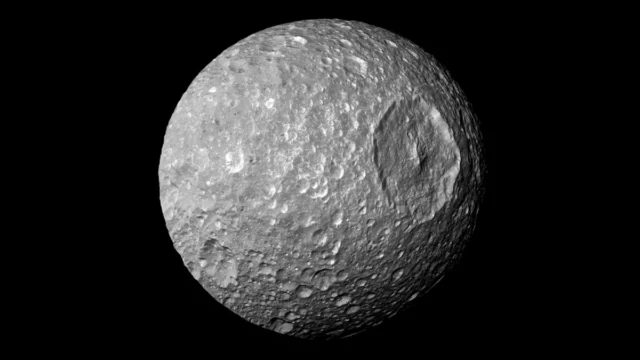
Saturn’s moon Mimas, often likened to the iconic Death Star from “Star Wars” due to its distinctive Herschel crater, harbors a secret beneath its icy exterior—a subsurface ocean, presenting a stark contrast to its seemingly inert surface riddled with craters. This revelation not only enriches our understanding of celestial bodies but also opens new avenues for exploring life’s potential beyond Earth.
Key Highlights:
- NASA’s Cassini spacecraft data reveals a subsurface ocean beneath Mimas’s icy shell, approximately 12-19 miles thick.
- The ocean’s discovery challenges previous perceptions of Mimas as a geologically inactive moon.
- Mimas is now among the solar system’s moons, like Enceladus and Europa, known to host subsurface oceans, suggesting potential habitability.
- The ocean is estimated to be relatively young, formed between 5 and 15 million years ago, raising intriguing questions about its origin and the dynamic processes at play within Saturn’s moons.
A Closer Look at Mimas’s Subsurface Ocean
Recent studies, drawing on data from NASA’s Cassini spacecraft, have shed light on the presence of a liquid water ocean beneath Mimas’s thick ice layer. Initially, the moon’s appearance—dominated by the massive Herschel crater—gave no indication of such a feature. However, detailed analysis of Mimas’s rotational motion and orbital characteristics revealed anomalies that could only be explained by the presence of an internal ocean, not a solid core.
Unveiling the Mystery: A Scientific Breakthrough
The discovery is attributed to a team led by Valery Lainey from the Observatoire de Paris, who meticulously analyzed Cassini’s measurements. By examining Mimas’s spin and the precise orientation of its orbit over time, researchers identified a slight but significant drift, inconsistent with a solid core but indicative of a subsurface ocean. This ocean, concealed under 20 to 30 kilometers of ice, marks Mimas as the smallest moon in our solar system known to possess such a feature.
The Origin of Mimas’s Ocean: An Enigma
The emergence of Mimas’s ocean is a puzzle, hinting at a past event that reshaped its orbit, increasing the gravitational pull from Saturn and consequently melting ice into water. Hypotheses suggest a brief interaction with other moons or a disruptive event in Saturn’s moon system as possible triggers. Despite the ocean’s relatively recent formation, its existence challenges current understanding of celestial dynamics and the conditions conducive to life.
Implications for Astrobiology and Future Exploration
Mimas’s subsurface ocean elevates its status as a target for future exploration, offering insights into the solar system’s evolutionary history and the potential for life in seemingly inhospitable environments. The findings underscore the diversity of ocean worlds and the complexity of their internal processes, paving the way for more detailed studies of Saturn’s moons and potentially those orbiting other planets.
Conclusion
The discovery of a subsurface ocean on Mimas adds a compelling chapter to the story of Saturn’s moons, blending the allure of science fiction with the rigorous inquiry of science. It not only challenges our preconceived notions about where life could exist but also highlights the solar system’s dynamism and the ever-present potential for new discoveries. As we continue to probe the mysteries of space, Mimas stands as a reminder of the wonders that await us, hidden beneath surfaces waiting to be unveiled.











